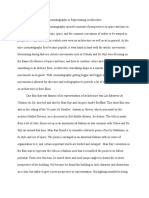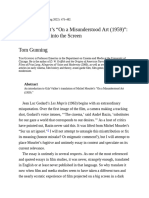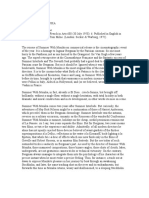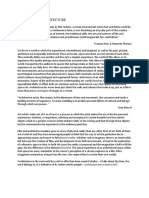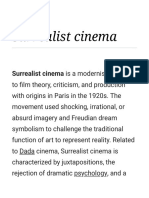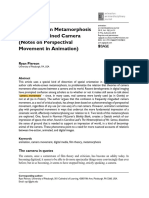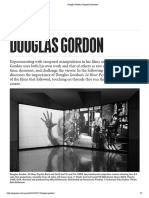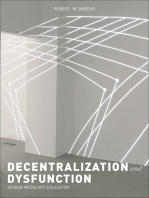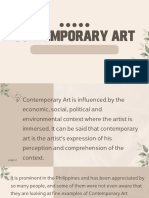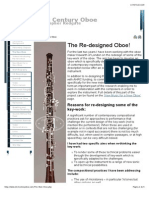City and Cinema
City and Cinema
Uploaded by
theijesCopyright:
Available Formats
City and Cinema
City and Cinema
Uploaded by
theijesOriginal Description:
Copyright
Available Formats
Share this document
Did you find this document useful?
Is this content inappropriate?
Copyright:
Available Formats
City and Cinema
City and Cinema
Uploaded by
theijesCopyright:
Available Formats
International Journal of Humanities and Social Science Invention
ISSN (Online): 2319 7722, ISSN (Print): 2319 7714
www.ijhssi.org ||Volume 5 Issue 9||September. 2016 || PP. 20-25
City and Cinema
zden Toprak1
Cinema has created a new vision as a popular entertainment among the art branches since 1910s. Walter
Benjamin, like Kracauer, the pioneer in the field of city and cinema, observed from the beginning of the century
that the city formed the largest cultural communication system. These new forms of urban life accompany the
common history of newborn cinema.
With the birth of the modern city culture, the expressions of Kracauer and Walter Benjamin drew the
sketch of such approach in the beginning of the century, during which the cinema reflected the modernity.
According to Benjamin, only the art of film could provide a visual introduction to the essence of the city in a
modern environment.
Questioning the modern city in a sociological perspective opens new horizons in theorizing the
relationship between the cinema and modernity.
Since the 19th century, when Walter Benjamin observed that the city was dependent on a cultural,
literal, photographic and mapped communication system making the media of the era and the dynamics of the
city clash with each other, the city has had homogeneity only in sight. Even the name of the city has been
emphasized in a different way according to its region. (Passages, 1989)
Cinema and cities are special fields in which the different conversions of the modernity were handled
at the turn of the 20th century. The cinematic forms, hereafter, do not have to keep up with the urban forms.
Cinema recreates the city as a city phenomenon. During the whole twentieth century, cinema was dominant in
the spread of the new cultural urban models. The fifth Element (Luc Besson - 1997) is an example for this. The
creation of a lost city with a futurist perception was realized by the cinema and the nostalgic outlook of the city
was historically renewed.
I. EMERGENCE OF MODERN CITY AND CINEMA
Modern city and cinema occurred as an urban discovery at the end of the 19th century. This discovery
was not limited only with the cities which were associated with modernity such as Wien, Berlin, Paris. Cinema
also told about the cities like Alexandria, Cairo, Istanbul, Bombay. Due to this important feature, the significant
thinkers and artists did not disregard the cinema, which lives on the city stories and pictures.
To paraphrase Walter Benjamin, "Then came the film and burst this prison-world asunder by the
dynamite of the tenth of a second, so that now, in the midst of its far-flung ruins and debris, we calmly and
adventurously go traveling. Apollinaire is one of the first thinkers stating that there must be a relationship
between cities as the mechanism of the modernity and the cinema. (Trkolu, ztrk, Aymaz; 2004, p.7)
City and cinema are privileged areas where modernity comes into existence and is reflected. However,
with the time-setting relation which is the main element of the cinema, the European city model gave its place to
a more vigorous metropolitan model in 1920s. Especially after Kracauer and Benjamin, revaluation of this
relationship between cinema and city offers an endless variety of modernity through which each one of these
megapolises is perceived as a plural modernity group.
Cities which are examined and filmed like Berlin, Cairo, Los Angeles, Istanbul, Paris, Prague are, at
the same time, natural tablelands and studio-settings as resources. The films taking the road from these settings
also reflect the city sceneries which form the fiction basing on a new reality.
In this way, a promise of happiness for founding a livable and desirable citywhere the world cinema is
raised, by crossing the framework of the mysterious relationship between city, memory and history. Apart from
the perceptions of Kracauer and Benjamin, the other cinema artists adopt this promise and utopia. (ztrk,
2008, p.5)
II. PRESENTATION OF THE CITY IN CINEMA
As from 1920's, theme of city became a separate field. Portraits of Paris were manifold and after
documentaries, they were used in avangarde cinema and then in fiction. (ztrk, 2008, p.284)
Cinema has documented the special and detailed moments of the cities from different points of view
and will continue to do so. When reinterpreted by the cinema, cities gain different features. Because cinema
feeds on the aesthetic concerns of the art.
Ass. Prof., Istanbul Gelisim University
www.ijhssi.org
20 | Page
City And Cinema
Films re-establish the non-existing places. Then how should we refer to the presentation of city in
cinema? The presentation of the city is the functioning of the tumultuous urban conditions which often change.
Urban memories and visions are re-interpreted by taking into consideration some key settings or moments. The
active characters of the city come into prominence in the film art. Both cinema and city are the areas where the
world of life can be reimagined. (ztrk, 2008, p.3)
The cities of the cinema sometimes entertain and sometimes sadden the audience. The audience
sometimes, in the mood of carnival, dream of themselves walking in a street lighted up with neon. They
sometimes also get lost in the dark suburbs where they normally never want to be. The cities, which the cinema
creates, revive the true-life loves, unforgettable deaths in the audiences mind.
Michel Marie: From the first films until the films of 1990s, the eighty percent of the films had been
shot in an urban setting throughout the history of cinema. Cinema is an urban discovery. Born in the Lyons
suburbs, the cinema took its first step in the big boulevards of Paris. As the pictures of Lumierre show many
squares and center of the city, these pictures are the witnesses of the then cities. (Trkolu, ztrk, Aymaz,
2004, p.59)
City, as a setting, is a place where the social inequalities are reorganized, in other words, new ones are
created. City inholds the richest expressions of the civilizations and reproduces them with new forms. This
production appears in a wide spectrum, from commercial relations to social transformation, from performing
arts to daily living. In the Greek, Roman and Islamic understandings, city is always referred to as the opposite of
barbarity and chaos. City, at the same time, is synonymous with civilization. Cinema, a modern cultural
structure, also accompanies the urban civilization. However, if the modern urban setting inholds an elegant life,
it also inholds the chaos and barbarity. (ztrk, 2002, p.11)
According to Robert Park, city is a big picking mechanism infallibly choosing the individuals from the
entire population who adapt to living in a special setting best. Cities are the settings turning people into lonely
crowds. For this reason, the cities are important picking mechanisms in the modern world or the world which
tries to be modern. (Elmac, www.belgeler.com)
III. CINE-CITY
Deriving from the urban films, Kracauer who put forth a concept of cine-city examined the modernity
sights within a sociological framework. Discussing the characters of the modernity through the street and city
scenes in a critical method, Kracauer comes up with psychological, sociological, philosophical ideas basing on
the form of the film. Establishing his theory as film as the redemption of the physical reality, Kracauer applied
a method which was useful to analyze the social tendencies, ideological hegemonies and psychological
characters of the masses through the codes in city scenes.
Kracauers perception of cine-site can also be seen in Godards films. Cinematographic materials in
Godards films are the aestheticized unity of liveliness of streets and roads and urban complexity.
Many good and bad film examples of the film art were carried out in cine-sites. New cinematographic
sites and metropolises are envisaged in the cine-sites established in Paris, New York, Los Angeles, Berlin,
Rome and Hollywood.
From time to time, the realistic power of the films shot in studios can leave a more realistic and better
impression than that of the ones shot in natural settings. An aesthetics proposition of Apollinaire, the poet of
Modern City and Light Era, summarizes the situation: The reality is moving towards the fiction. The one to
create the reality is the fiction. Godards proposition on this issue is: As all significant documentary films are
built with fiction, the all significant fictional films are built with documentary.
Other than modern symphonicurban films, it was also shown with its attractive, fascinating and offputting features in the works of the artists like Balzac, Dostoyevsky, Dickens, Gogol, Baudelaire and Rimbaud.
No matter in what way they are demonstrated, the cities are irreplaceable elements of the other arts. (ztrk,
2002, p.13-14)
IV. VIEW OF CITY
Kevin Lynch was saying that in 1960s the cities would be challenging places for people and that the
urbanites would be urged to prepare cognitive maps in the places, the geography, physics and experiences of
which were in a process of change and these maps were the most important instruments to survive in the cities.
(Salp, 2004, p.76)
The concept of cognitive mapping, introduced into the literature by Lynch, signifies that the
relationship which the man on the street established with the city to survive and keep living in daily life in the
cities changing after 1960s would be possible through a kind of abstract agreement, consensus and adaptability
in mind. According to Lefebvre, the setting is produced by the society. (Lefebvre, 1991) The interclass conflicts
in this social production determine the form of the production of the setting. The socially produced setting itself
www.ijhssi.org
21 | Page
City And Cinema
is a dynamic and dialectic density in the activity areas from architecture to urban policies, from environmental
problems to land speculations and from cultural production to ideology.
The cities are also the representation areas of this density. The representation of the city enables us to
analyze its all segments at philosophical and artistic levels and creates a form of recognition. How we perceive
the environment we live in is determined by a multifaceted, multi-related clew extending from economy to
technology, from architecture to the music played on the streets, from infrastructure works to ecological
balances. (Salp, 2004, p.91)
In 1982, Ridley Scotts film of Blade Runner took the city out of being a setting and turned it into a
composition of dilemmas and queries that we have in daily life and reflected that visually. This film is a
prediction for todays world. Because it forms the initial elements of the city for the establishment of separate
living environments in the context of social classes. The film begins with an image of a blue eye reflecting the
overall view of the city. That the buildings, twinkling like a star in the darkness of the night, are dark and dull
colored, factory chimneys leaving the sky in flames, a smoke screen and continuous rain draw a pessimistic
future altogether.
While conveying this aspect of the city, Ridley Scott used architectural characters, applied light and
shadow tricks and to some extent the computer effects. (Allmer, 2010, p.128) We see a post-industrial society in
the city of Blade Runner. All kinds of industrial, manufacturing and citys notable strata were moved from the
worn-out, ruined city to the settings where life is more sterile and programmed.
The geography of the city changed, the center of the city disappeared from the surface of the city, and
the old city center was left to the lumpen proletarian coming from all over the world. This physical setting is the
setting of the human trashes and they live together with the cultural trashes and all the left objects. The street
children turning into the evil spirits, buildings, seats, cars, old cinema halls, ethnic music, ethnic restaurants are
like the doorstep junks waiting for the junk dealer's passing. (Salp, 2004, p.79)
In Blade Runner, there is the creation of a virtual and distopian city. Godard's film of Alphaville (1965) has
some similarities with Blade Runner (1982). "Blade Runner borrows the style features of Godard's city with
endless night, sometimes even the lighting methods, use of music and form of acting. (Trkolu, ztrk,
Aymaz, 2004, p.132)
In the film of Metropolis (F.Lang), one can notice the tyrannic and planned, orderly structuring
accordingly. The years ahead were extraordinarily envisaged and imagined in the film. The Metropolis shot in
1927, displayed architecture of good life with the city's structure, transportation, traffic, entertainment venues,
magnificent buildings, skyscrapers and big gardens. The Metropolis is a nested presentation of the old and the
new. The big giant sculptures, overwhelmingly high buildings, embroideries, decorations and minimal living
environments in contrast with all these hint the power of leadership. The building of the city was highly inspired
by Renaissance, Baroque, Gothic periods.
The concept of the metropolis comes with the dilemmas. The city, where the different and various
elements exist together, is actually a center of chaos. (Allmer, 2010, p.111) Kevin Robins, The urban city is
associated with the experience of aggression and violent behavior. Even when this is contained, there is fear and
anxiety. Mumford refers to 'the deepened collective anxieties' that characterize urban culture, suggesting that
urban life encourages a 'paranoid physical structure'. Urban life is about struggle, aggression, domination,
conquest and servitude; the city is the container of 'disruptive internal forces, directed towards ceaseless
destruction and extermination.' Urban culture may be seen (in Hobbesian terms) as a constant state of hostility
and struggle. Feelings of anxiety and fear are, then, constitutive of urban life." (Robins, 1999, p.214)
V. CITY PORTRAITS: CITIES AS NATURAL DECORATIONS
The film set of Alphaville is the actual Paris of 1965. There is no studio filming. Lemmy Caution travels
to Alphaville for a job that he is charged with. One can fully envisage the science fiction city of the future
directed by a computer with a tedious sound and the city appears as a rationalism maintained with scientific
precisions extending over feeding, traveling, working, sexual life, sheltering and architecture.
Generally, in the urban presentations of French and Italian cinemas, Paris and Rome, in particular, were
presented in a glorified way, with their naturalness and in a way of "there and then". In such films as Blade
Runner, Alphaville, Escape from New York, the city was presented in a distopian way.
The city portraits were reproduced in 1920's. 'Berlin: Symphony of a Metropolis' (1927) directed by
Walter Ruttman, unifying Moscow and Odessa 'Man With a Movie Camera' (1929) directed by Dziga Vertov,
' propos de Nice' (1930) directed by Jean Vigo are the extraordinary witnesses of the then perception of city.
According to Andre Bazin, the Bicycle Thieves" (De Sica 1948), a story of a walk through Rome by a
father and a son, "Rome, Open City" (Rossellini-1945), another film putting forth the criteria of New Realist
Cinema and "The Sweet Life" (Fellini-1960) are the films approaching towards the city of Rome from different
points of view. While Rome was a natural decoration of the ones who could not buy a bicycle and were defeated
by the life, it was the decoration of unhappy nobles in La Dolce Vita.
www.ijhssi.org
22 | Page
City And Cinema
The gangster films and musical comedy films in USA; Under the roofs of Paris (1930), July 14 (1933)
directed by Rene Clair, Isn't Life a Bitch (1931) and The Crime of Monsieur Lange (1936) directed by Jean
Renoir. In this period, the cinema, in fact, undertakes the responsibility of presenting the city.
Although it is traditionally considered that the studio won a victory and the shootings became rare in
1940's and 1950's, there are many opposite examples for this. For example, 'We, The Kids' (1943) directed by
Louis Daquin, 'Devil in the Flesh' (1946) directed by Claude Autant-Lara, 'Quey of Goldsmiths' (1947) directed
by Henri-Georges Clouzot.
At the end of 1950's, cinema accompanies 'urban revolution'. 'Breathless' (1960) directed by Jean-Luc
Godard, 'The 400 Blows' (1959) directed by Francois Truffaut, 'Elevator to the Gallows' (1958) and 'Zazie dans
le mtro' directed by Louis Malle, 'A Woman Is a Woman' (1961), 'Vivre sa vie' (1962), 'Alphaville' (1965),
'Two or Three Things I Know About Her' (1967) directed by Godard, can be the examples. (Trkolu, ztrk,
Aymaz, 2004, p.62)
VI. ISTANBUL: THE CAPITAL OF POETIC FILMS
The films of A Love Tragedy in Istanbul (1923) and In The Streets of Istanbul (1931) directed by
Muhsin Erturul presented Istanbul thematically for the first time.
Such films as Tricycle (1962-Ltfi . Akad), Those Awakening in the Dark (1964-Ertem Gre), Birds
of Exile (1964-Halit Refi), The Unending Road (1965-Duygu Sarolu), Ah Beautiful Istanbul(1966-Atf
Ylmaz), My Prostitute Love (1968-Ltfi . Akad), Little Aye (1959-1971), The Bride (1973-Ltfi . Akad),
The Horse (1981-Ali zgentrk), Distant (2002-Nuri Bilge Ceylan), Tell Me Istanbul (2005-mit nal, Selim
Demirdelen, Kudret Sabanc, Ycel Yolcu, mr Atay) depicted the different views of Istanbul and approved
the variety of modern life forms in Istanbul.
In other words, cinema offered "cities" and life forms which are quite different from Istanbul. Taking
into consideration the whole big modern city, the existence of variety can be understood after all.
Throughout the modernization of Istanbul, new forms of the city like industrialization, migration to the
city, housing problem, shanty house, contradictions between center-suburb, cultural shocks, unionization,
social/class conflicts, womens gradually becoming more active in both daily and labor lives, disappearance of
sense of family, new cultural inclinations, changing awareness and emotions; and social/individual views like
increasing alienation recently and people left behind to their "destinies" and "loneliness" were described in the
films.
In most films, Istanbul was shown as a door of hope "paved with gold", but as the narration continued,
it was ended with disappointments. The films like 'The Horse' of Ali zgentrk, 'The Bride' of Ltf mer
Akad or 'The Birds of Exile' of Halit Refik are the classics representing the modernity/traditionality conflicts
and the saddening results in Istanbul. (metropolistanbul.com)
The films, telling the stories of depression in metropolises occurring after 1990, tell us about the people
left behind and trying to hold on to the city in any way rather than to cling to the migration from rural to urban
itself, such as Whistle If You Come Back, The Night, Angel and Our Gang, The Bandit, The Mixed Pizza',
A Madonna in Laleli', Somersault in a Coffin', Innocence, Cholera Street', Big Man, Little Love, Offside'
, Hemo, Journey to the Sun, Block C.
As An Example Film:
A MIDNIGHT IN PARIS
"Paris changes! but nothing in my melancholy,
Has moved! New palaces, scaffolding, blocks,
Old suburbs, all for me becomes allegory,
And my dear memories are heavier than rocks."
Baudelaire (Tableaux Parisiens)
The Surreal Table of Woody Allen
Winning the 2012 Golden Globe Awards for Best Screenplay and opening the 64th Cannes Film
Festival, Midnight In Paris directed by Woody Allen is the story of a young man's deep love for Paris and
literature...
Champs Elysees, Eiffel, Louvre, Notre Dame, The Arc de Triomphe... With a long scene of Paris
begins the film. Its suburbs, dark streets are the images made with the backgrounds that we do not see. We can
say that Midnight in Paris is one of the films in which Woody Allen tells the cities. With both its current state
and its state in the 18th and 19th centuries, Paris establishes the decoration of the film.
Leading actors of the film are Owen Wilson, Rachel McAdams, Marion Cotillard, Kathy Bates, Carla
Bruni, Adrien Brody. The scenario winning the Golden Globe Award was written by Woody Allen. After saying
goodbye to America with his film Hollywood Ending of 2002, Allen shot a series of urban films and fell in love
www.ijhssi.org
23 | Page
City And Cinema
with these cities. London (Match Point - 2005, Scoop - 2006, You Will Meet A Tall Dark Stranger - 2010),
Barcelona (Vicky Cristina Barcelona - 2009) and Paris. His devotion to and love for these cities reveal in every
frame. These films are the films that cannot be imagined without the cities where the stories are filmed.
Midnight in Paris is also a film of Paris of today and 1920's. As can be understood from the name of
the film, Woody Allen shows Paris of 1920's after midnight. We witness the present time in the daylight.
The story of a family coming from America to Paris for a job is told in the film. The life of a young
engaged couple that is changing continuously through the journey is told in Woody Allen style. Planning to get
married in autumn, the American couple is passionately in love with Paris. They stress their admiration for this
city by saying "this city is unique in the world." While aestheticizing the city, the film also displays a deep love
for art and literature.
Gil (Owen Wilson) keeps working on his book in Paris, where he came due to the works of his fiance
Inez's (Rachel Mc Adams) dad. Gil (Owen Wilson), stating that Paris inspires him, is so fascinated by Paris that
he plans to settle in this city. However, Inez and her family object to him and think that Gil is a daydreamer. In
family meetings, dissensus shows its face. Addiction of Inez's family to luxury and their materialist approaches
do not overlap with Gil's approaches and ideals.
When Paul (Micheal Sheen) and his wife join the couple in their Paris tours, Gil begins to feel lonely
and he goes away from everybody and tours Paris on his own. Gil's personality characteristics of loving the past,
almost living with the past and feeding on this love also in his writings, are pretty different from those of his
fiances and their friends.
While Paul thinks that "nostalgia is the rejection of the time", Gil often states his admiration for the
writers and painters in the past and Gil goes for a long walk by thinking that the streets of Paris would inspire
him in the silence of the night, but he gets lost. Meanwhile, he stops in front of an old car and the people inside
the car insistently invite him in. After getting into this car, Gil enters another period and takes the opportunity to
meet all the artists that he admires.
Gil starts his time travel with listening to "Let's Do It" of Cole Porter in a party that Scott and Zelda
Fitzgerald also participate in. He finds a chance to discuss literature with Gertrud Stein. He obtains a promise
for an evaluation of his book which is still incomplete. Gil gets lost with Ernest Hemingway in the love
adventures of Picasso. He meets Salvador Dali. While having a talk with Luis Bunuel, Man Ray and Dali, Gil
tries to explain that he comes from 2000's by saying that "I know that you are surrealists, too. What I tell is
ordinary for you, but this all is real..." When bringing his book to Gertrud Stein for his reading, Gil uses the
concept of "science fiction" for his book which he wrote in 2000's, from the point of Stein's period and
compliments by saying "it is a real science fiction", which is one of the striking dialogues.
This "surrealist" travel offers Gil the world that he wants to live in. To go back to today's modern Paris
under the daylight and to spend time with his fiance and her family is no longer bearable for him.
His fiances father hires a detective to follow Gil due to his suspicious behaviors. However, the
detective also has to travel in time. When Inez's father goes to the detective's office, he finds out that nobody
knows about the detective. He is not as lucky as Gil, though. Because it is not possible to stay wherever you
want in time travel and he gets lost in Baroque era.
With a fast running, fluent fiction and a fabulous narration in A Midnight In Paris, Woody Allen
enables all art-lover audience to experience the streets of Paris in an imaginably beautiful way. In addition, there
occur the sophisticated texts making someone question the "Golden Era": Is the end of the 19th century "Golden
Era" or is today's Paris?...
Gil gets stuck between two loves; the life brought by the world of arts and romanticism in 1920 and the
realist, materialist life in 2010. He thinks and questions. Reflecting this dilemma, Woody Allen never tells a
love story to the audience. Is the "Golden Era" that everybody dreams of in the past? After everything that he
experiences in his own "Golden Era", Gil notices that this is an illusion. What Adriana, whom he met in 1920's,
dreams of is 1890's, "Belle poque" (*).
When they go back to Belle poque, this dialogue between him and Adriana who wants to stay in that
era reveals the reality that everybody's "Golden Era" is different from each other:
"Adriana: Let's never go back to 1920's.
Gil: What are you talking about?
A: I think we should stay here. This is the greatest, most beautiful era Paris has ever known.
G: What happened to 1920's? Then... ,Charlestone, Fitzgerald, and Hemingway, I like these people.
A: That's the present. It's dull.
G: Is it dull? It's not the present for me. I'm from 2010.
A: What do you mean?
G: I dropped in on you just the way we dropped in on the 1890's.
A: You did?
G: I wanted to escape my present just like you wanted to escape yours, to a "Golden Age".
www.ijhssi.org
24 | Page
City And Cinema
A: Surely you don't think 1920s are a golden age?
G: To me it is.
A: But I'm from the twenties and I'm telling you the golden age is the "Belle poque".
G: Yes but don't you see that to these guys the golden age is the Renaissance. They'd all trade the Belle poque
to paint alongside Michelangelo or Titian. And those two guys probably imagine life was better when Kubla
Khan was around. I'm having an insight, a minor one. But that accounts for the anxiety of my dream.
A: What dream?
G: Last night I dreamed, actually had a nightmare that I ran out of antibiotics and then I went to the dentist and
there was no novacaine. Do you understand? These people have no antibiotics."
Adriana wants to stay in this era. Gil comes to his senses at this point. He realizes that everybody wants to
escape from their era and this is never-ending. Saying that only if I get rid of my own illusions, I can be a good
writer, he turns a brand new page on the concept of artist.
The film underlines the superficial changes in Paris of the related eras, shows us how the dresses of the people,
the vehicles they use, the decorations of the places where they go in the nightlife change; displays, at the same
time, that the city and the urbanites noodle over the same problems; despite the changes on the surface, the lives
of city and urbanites are, in essence, the same.
(*) Belle poque: It is the period in European history dated from the end of the 19th century to the outbreak of
World War I; Beautiful Era.
BIBLIOGRAPHY
[1].
[2].
[3].
[4].
[5].
[6].
[7].
[8].
[9].
[10].
ztrk, Mehmet (Compiler), Sinematografik Kentler -Mekanlar, Hatralar, Arzular-, Istanbul, Agora
Kitapl, 2008.
Salp, Tl Akbal, Zamanmekan-Kuram ve Sinema, Istanbul, Balan Publishing, 2004.
Allmer, Aalya, Sinemekan, Istanbul, Varlk Publications, 2010.
Robins, Kevin, Grmenin Kltr ve Politikas, (Translator Nuray Trkolu), Istanbul, Ayrnt
Publications, 1999.
Trkolu, Nuray-Aymaz, Gksel-ztk, Mehmet, Kentte Sinema Sinemada Kent, Istanbul, Yenihayat
Publishing, 2004.
ztrk, Mehmet, Sine-masal Kentler, Istanbul, Om Publication, 2002.
Krel, Serpil, Trk Ve Dnya Sinemas zerine Sentezler, Parmen Publishing, Istanbul, 2011.
Journalof Yeni Film, Periodical, Issue:24, November-2011.
http://www.metropolistanbul.com/public/home.aspx?tmid=15 (Date accessed: 06.01.2012)
Elmac, Tuba, Son Dnem Trk Sinemas'nda Kentli Kimlik Balamnda tekinin Sunumu, Dokuz
Eyll University, Graduate School of Fine Arts, Cinema-TV USA. Post-Graduate Thesis, zmir, 2006.
(http://www.belgeler.com/blg/r4h/son-donem-turk-sinemasi-nda-kentli-kimlik-baglaminda-otekininsunumu-representation-of-the-other-in-context-of-urbanite-identy-in-contemporary-turkish-cinema
(Date accessed: 04.01.2012)
www.ijhssi.org
25 | Page
You might also like
- Julian Barnes History of The World in 10 andDocument3 pagesJulian Barnes History of The World in 10 andSebastian PontusNo ratings yet
- GoogleAdsence支票Document1 pageGoogleAdsence支票noetic83867% (3)
- Robert Sinnerbrink - Cinematic Ethics - Exploring Ethical Experience Through Film-Routledge (2016)Document231 pagesRobert Sinnerbrink - Cinematic Ethics - Exploring Ethical Experience Through Film-Routledge (2016)Mauricio BaezNo ratings yet
- Lang, Pabst and Sound - CarrollDocument9 pagesLang, Pabst and Sound - CarrollBrian SmithNo ratings yet
- DeValck Loist 2009 FilmFestivalStudies DoublepageDocument19 pagesDeValck Loist 2009 FilmFestivalStudies DoublepageĐurđija RadivojevićNo ratings yet
- 02 Poetic DocumentaryDocument2 pages02 Poetic DocumentaryVaibhav AhireNo ratings yet
- Relocating American Film HistoryDocument42 pagesRelocating American Film HistoryvaldigemNo ratings yet
- Data HP Authorised Retail StoresDocument2 pagesData HP Authorised Retail StoresParas SatijaNo ratings yet
- Edward Dim End Berg - From Berlin To Bunker Hill - Urban Space, Late Modernity, and Film Noir in Fritz Lang's and Joseph Losey's M - Wide Angle 19 - 4Document20 pagesEdward Dim End Berg - From Berlin To Bunker Hill - Urban Space, Late Modernity, and Film Noir in Fritz Lang's and Joseph Losey's M - Wide Angle 19 - 4AnarchivistaNo ratings yet
- The City in Twilight Cinema and Architecture Part OneDocument20 pagesThe City in Twilight Cinema and Architecture Part OneMohamed Kamal100% (1)
- Dynamic of The Metropolis The City Film and The Spaces of ModernityDocument373 pagesDynamic of The Metropolis The City Film and The Spaces of ModernityFermín Eloy Acosta100% (1)
- The Attractions of The Cinematic CityDocument19 pagesThe Attractions of The Cinematic CityBru LaboiNo ratings yet
- Cinema and the City: Film and Urban Societies in a Global ContextFrom EverandCinema and the City: Film and Urban Societies in a Global ContextNo ratings yet
- Babette Film in Social Context: Reading For Class #5Document9 pagesBabette Film in Social Context: Reading For Class #5monaflorianNo ratings yet
- Kim Ki DukDocument6 pagesKim Ki DukRajamohanNo ratings yet
- A Farcical RealismDocument11 pagesA Farcical RealismeagledevNo ratings yet
- Screen - Volume 35 Issue 4Document123 pagesScreen - Volume 35 Issue 4Krishn KrNo ratings yet
- French Poetic Realist Cinema - MccannDocument8 pagesFrench Poetic Realist Cinema - MccannJavierSánchezNo ratings yet
- Cinematography in ArchitectureDocument2 pagesCinematography in ArchitectureRicky GardnerNo ratings yet
- Michel Mourlet - On A Misunderstood ArtDocument34 pagesMichel Mourlet - On A Misunderstood ArtGabriel CarvalhoNo ratings yet
- Guiliana - Bruno Despre HAPTIC PDFDocument14 pagesGuiliana - Bruno Despre HAPTIC PDFBogdan Tanase-Marinescu100% (1)
- Johan Van Der Keuken - Montage Collage InterviewsDocument38 pagesJohan Van Der Keuken - Montage Collage Interviewsdelphinne descubrirNo ratings yet
- Maya Deren PDFDocument19 pagesMaya Deren PDFNiharika SharmaNo ratings yet
- Film and Art After CinemaDocument210 pagesFilm and Art After CinemaLuka LucaNo ratings yet
- SUMMER WITH MONIKA GodardDocument2 pagesSUMMER WITH MONIKA Godardagfa777No ratings yet
- Cinema As Dispositif - Between Cinema and Contemporary Art - André Parente & Victa de CarvalhoDocument19 pagesCinema As Dispositif - Between Cinema and Contemporary Art - André Parente & Victa de CarvalhoFet BacNo ratings yet
- An Architectural Review of Metropolis (1927)Document2 pagesAn Architectural Review of Metropolis (1927)Anonymous GKLPtGgRqNo ratings yet
- Cahiers - Du - Cinema - 1960-1968 - 28 Roland BarthesDocument10 pagesCahiers - Du - Cinema - 1960-1968 - 28 Roland BarthesXUNo ratings yet
- Badiou The False Movements of CinemaDocument6 pagesBadiou The False Movements of CinemaZac SettleNo ratings yet
- OKJADocument115 pagesOKJAFurinflaisNo ratings yet
- Hans Richter - The Film As An Original Art Form (1951)Document6 pagesHans Richter - The Film As An Original Art Form (1951)Tiko MamedovaNo ratings yet
- James Coleman (October Files) by George BakerDocument226 pagesJames Coleman (October Files) by George Bakersaknjdasdjlk100% (1)
- The Surrealist Roots of Video EssaysDocument5 pagesThe Surrealist Roots of Video EssayspsicorticoNo ratings yet
- Photography - HistoryDocument27 pagesPhotography - HistoryMiguelVinci100% (1)
- Cinema and Architecture Deep Shah-LibreDocument4 pagesCinema and Architecture Deep Shah-LibreaujalanaveedNo ratings yet
- Sunrise Expressionism EssayDocument1 pageSunrise Expressionism EssayKira MooreNo ratings yet
- Director Jaques TatiDocument1 pageDirector Jaques TatiBerin ÇubukçuoğluNo ratings yet
- Art and Reality - The Construction of MeaningDocument14 pagesArt and Reality - The Construction of MeaningLucas EdNo ratings yet
- (Thompson, Kristin) Space and Narrative in OzuDocument33 pages(Thompson, Kristin) Space and Narrative in OzuAgustina Pérez RialNo ratings yet
- Morgan - Rethinking Bazin - OCRDocument39 pagesMorgan - Rethinking Bazin - OCRNuri Dom Ripley100% (1)
- Surrealist CinemaDocument27 pagesSurrealist CinemaRebekah WalterNo ratings yet
- Bellour (Psychosis, Neurosis, Perversion)Document29 pagesBellour (Psychosis, Neurosis, Perversion)Seung-hoon Jeong100% (1)
- Sculpting in Time With Andrei Tarkovsky PDFDocument4 pagesSculpting in Time With Andrei Tarkovsky PDF65paulosalesNo ratings yet
- Pierson - Whole-Screen MetamorphosisDocument16 pagesPierson - Whole-Screen MetamorphosisanuragNo ratings yet
- Naked Film: Dogma and Its Limits - Berys GautDocument7 pagesNaked Film: Dogma and Its Limits - Berys GautyaqovlNo ratings yet
- Douglas Gordon Katrina Brown, Gagosian QuarterlyDocument7 pagesDouglas Gordon Katrina Brown, Gagosian QuarterlyArnaud JammetNo ratings yet
- A Certain Tendency of The French CinemaDocument12 pagesA Certain Tendency of The French Cinemathesupernova3No ratings yet
- Framing Pictures Film and The Visual ArtDocument1 pageFraming Pictures Film and The Visual ArtlsdkdhfNo ratings yet
- STOLLER - Artaud, Rouch and The Cinema of CrueltyDocument8 pagesSTOLLER - Artaud, Rouch and The Cinema of CrueltyGuilherme NaniniNo ratings yet
- From The Dark Chamber of The Lumiere BroDocument12 pagesFrom The Dark Chamber of The Lumiere Brochris g baosNo ratings yet
- CHRISTIAN METZ TrucageDocument20 pagesCHRISTIAN METZ TrucagenathanhNo ratings yet
- Man in A Suitcase Tulse Luper at Compton VerneyDocument13 pagesMan in A Suitcase Tulse Luper at Compton VerneyToldi GáborNo ratings yet
- Eisenstein, The Glass House and The Spherical BookDocument15 pagesEisenstein, The Glass House and The Spherical BookMarcos VilelaNo ratings yet
- A Cinema in The Gallery, A Cinema in Ruins: ErikabalsomDocument17 pagesA Cinema in The Gallery, A Cinema in Ruins: ErikabalsomD. E.No ratings yet
- Dadaist FilmsDocument4 pagesDadaist FilmsDiego GrañenaNo ratings yet
- Stella Bruzzi-Documentário, Performance e AutenticidadeDocument13 pagesStella Bruzzi-Documentário, Performance e Autenticidadelu2222No ratings yet
- Early Cinema Today: The Art of Programming and Live PerformanceFrom EverandEarly Cinema Today: The Art of Programming and Live PerformanceMartin LoiperdingerNo ratings yet
- The Beginnings Of The Cinema In England,1894-1901: Volume 1: 1894-1896From EverandThe Beginnings Of The Cinema In England,1894-1901: Volume 1: 1894-1896Rating: 5 out of 5 stars5/5 (1)
- Dysfunction and Decentralization in New Media Art and EducationFrom EverandDysfunction and Decentralization in New Media Art and EducationNo ratings yet
- Defluoridation of Ground Water Using Corn Cobs PowderDocument4 pagesDefluoridation of Ground Water Using Corn Cobs PowdertheijesNo ratings yet
- Development of The Water Potential in River Estuary (Loloan) Based On Society For The Water Conservation in Saba Coastal Village, Gianyar RegencyDocument9 pagesDevelopment of The Water Potential in River Estuary (Loloan) Based On Society For The Water Conservation in Saba Coastal Village, Gianyar RegencytheijesNo ratings yet
- Design and Simulation of A Compact All-Optical Differentiator Based On Silicon Microring ResonatorDocument5 pagesDesign and Simulation of A Compact All-Optical Differentiator Based On Silicon Microring ResonatortheijesNo ratings yet
- Mixed Model Analysis For OverdispersionDocument9 pagesMixed Model Analysis For OverdispersiontheijesNo ratings yet
- Influence of Air-Fuel Mixtures and Gasoline - Cadoba Farinosa Forskk Bioethanol Fuel Mixtures On Emissions of A Spark - Ignition Engine.Document9 pagesInfluence of Air-Fuel Mixtures and Gasoline - Cadoba Farinosa Forskk Bioethanol Fuel Mixtures On Emissions of A Spark - Ignition Engine.theijesNo ratings yet
- Lolo September 16-30Document1 pageLolo September 16-30Denielle Casimiro RabanezNo ratings yet
- Decanter Afdal SuccessDocument121 pagesDecanter Afdal Successkiller120No ratings yet
- A Brief Study of TheDocument14 pagesA Brief Study of Theasterion32100% (7)
- Listening Test PracticeDocument2 pagesListening Test PracticePaulettttteNo ratings yet
- Jet Airways Web Booking ETicket (PLTPWV) - LoboDocument3 pagesJet Airways Web Booking ETicket (PLTPWV) - LoboAamir KhanNo ratings yet
- PE PPT Group 2Document28 pagesPE PPT Group 2Menard NavaNo ratings yet
- 100523-GAU-DEL-Mr M HOQUE SIR+4 PDFDocument4 pages100523-GAU-DEL-Mr M HOQUE SIR+4 PDFBruce ElNo ratings yet
- Emperor Raja RAja CholanDocument2 pagesEmperor Raja RAja CholanKayalvizhi ArulandhuNo ratings yet
- Dados IPDocument35 pagesDados IPjonmartins686No ratings yet
- Devil in Disguise Characterizations of H PDFDocument14 pagesDevil in Disguise Characterizations of H PDFManousos LImbeNo ratings yet
- Falcao Pearl ABS Liquid v3 - VodicDocument11 pagesFalcao Pearl ABS Liquid v3 - VodicScribdelnaut100% (1)
- Contemporary ArtDocument29 pagesContemporary ArtPontejos Princess Dianne G.No ratings yet
- Camera Control Unit: CCU-D50 CCU-D50PDocument31 pagesCamera Control Unit: CCU-D50 CCU-D50Pflorinf_uNo ratings yet
- BH42SH60 0854PL 46kgcmDocument1 pageBH42SH60 0854PL 46kgcmYash PanchalNo ratings yet
- Class I HHW 2013Document5 pagesClass I HHW 2013amit_99chNo ratings yet
- Blue Delft: Web Bonus Lap SizeDocument4 pagesBlue Delft: Web Bonus Lap SizeVi FerNo ratings yet
- Ruggers - PoloPCDocument13 pagesRuggers - PoloPCEric ChambersNo ratings yet
- The Bamboo Ensemble of The Islamic People of MindanaoDocument21 pagesThe Bamboo Ensemble of The Islamic People of MindanaoRuthchel YaboNo ratings yet
- Procedure in Logrolling The PatientDocument1 pageProcedure in Logrolling The Patientcrrfrnc0% (2)
- Return To The Keep On The BorderlandsDocument68 pagesReturn To The Keep On The BorderlandsCellgamer666100% (3)
- Theatre Resume 20240309Document2 pagesTheatre Resume 20240309api-721849388No ratings yet
- 21st Century OboeDocument5 pages21st Century OboeBertrand Chavarria-AldreteNo ratings yet
- Tron Dance IndiaDocument7 pagesTron Dance IndiaglowdiatorsNo ratings yet
- SEDIMENTOLOGI (GL2151) - 4. Struktur Sedimen 1Document62 pagesSEDIMENTOLOGI (GL2151) - 4. Struktur Sedimen 1Muhammad RaviNo ratings yet
- ZXNVM E558S-D2-E: LCD Display UnitDocument2 pagesZXNVM E558S-D2-E: LCD Display UnitCarlos Quijandria CernaesNo ratings yet
- Codigo Descripcion Stock Precio Garantia Acces Accesorios Audifonos WirelessDocument18 pagesCodigo Descripcion Stock Precio Garantia Acces Accesorios Audifonos Wirelessjesus cameroNo ratings yet
- Irish Rail Presentation For Transport 21 BriefingDocument20 pagesIrish Rail Presentation For Transport 21 BriefingDublinChamberNo ratings yet



















